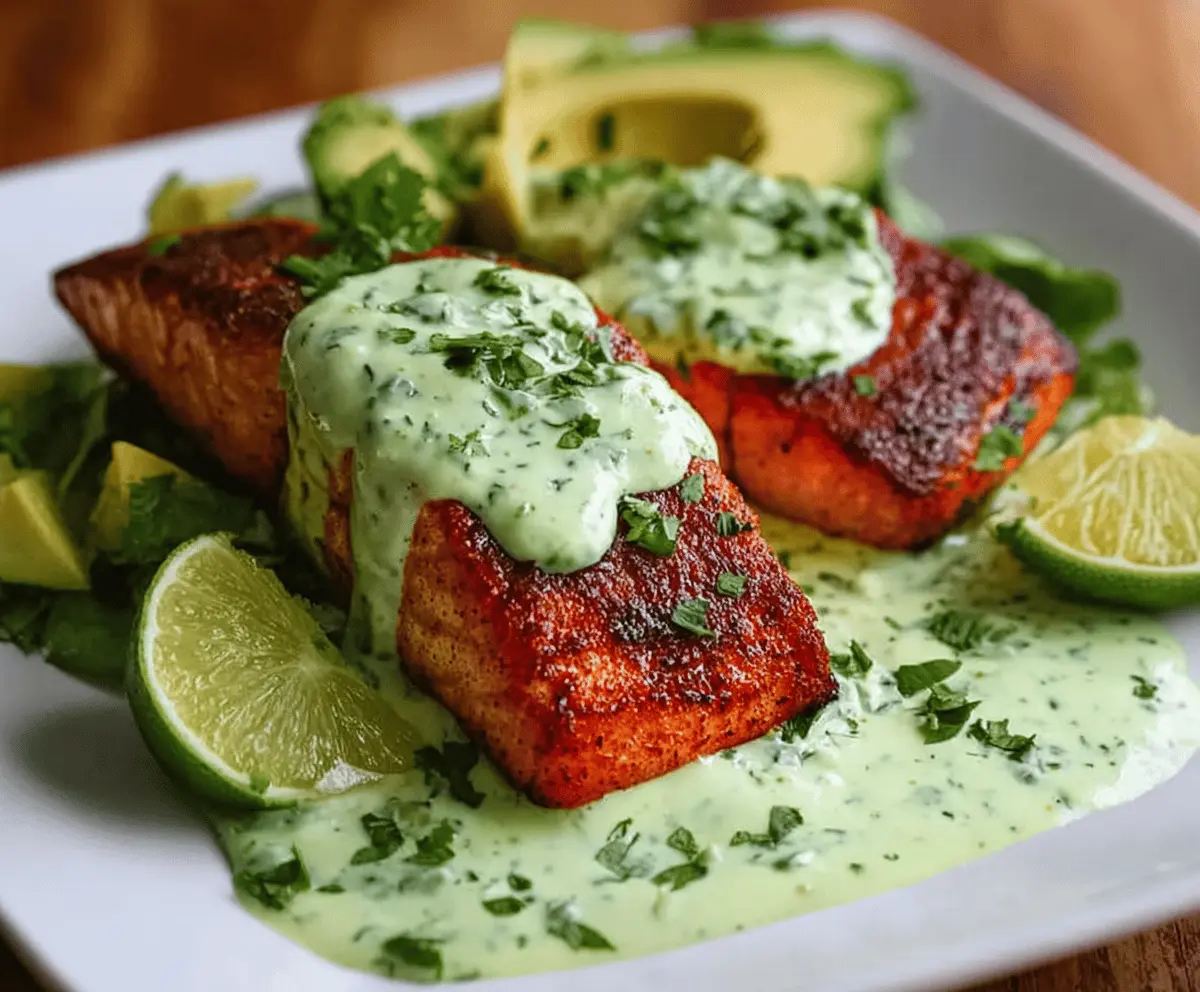This Cajun Salmon is a tasty treat! It has a spicy kick from the Cajun seasoning and pairs perfectly with a creamy avocado lime sauce. It’s a delicious way to enjoy salmon!
Cooking this dish is so easy! Just season the salmon, pan-sear it, and whip up that sauce. I love drizzling the sauce over the fish and enjoying it with rice or veggies. Yum!
Key Ingredients & Substitutions
Salmon: Salmon is the star of this dish! Fresh salmon fillets work best for flavor, but you can use frozen if you need to. If you prefer other fish, try tuna or tilapia, though their flavors will be different.
Cajun Seasoning: I love using store-bought Cajun seasoning for convenience, but you can easily make your own with paprika, garlic powder, onion powder, thyme, and cayenne pepper. Adjust the heat level to your liking!
Avocado: A ripe avocado adds creaminess to the sauce. If you’re out of avocados, consider using ripe bananas for a sweeter twist, or substitute with a little avocado oil and Greek yogurt for creaminess.
Sour Cream vs. Greek Yogurt: I usually use Greek yogurt for its tanginess and protein. If you’re dairy-free, cashew cream or a plant-based yogurt works great for the sauce!
How Do I Cook Salmon to Perfection?
Cooking salmon just right is key to this recipe! The goal is a crispy exterior and a tender interior. Here’s how to do it:
- Pat Dry: Make sure to pat the salmon fillets dry before seasoning. This helps get that nice crust.
- High Heat: Heat a nonstick skillet until it’s hot before adding the salmon. This gives it a nice sear and helps with sticking.
- Time Management: Cook undisturbed for 4-5 minutes on one side. This allows it to cook through without falling apart. Check for doneness by gently flaking with a fork.
With these tips, your salmon will come out delicious every time!

Cajun Salmon With Avocado Lime Sauce
Ingredients You’ll Need:
For the Cajun Salmon:
- 4 salmon fillets (about 6 ounces each), skinless or skin-on as preferred
- 2 tablespoons olive oil
- 1 tablespoon Cajun seasoning (store-bought or homemade)
- 1/2 teaspoon salt
- 1/4 teaspoon black pepper
For the Avocado Lime Sauce:
- 1 ripe avocado, peeled and pitted
- 1/3 cup sour cream or Greek yogurt
- 1/4 cup fresh cilantro leaves, roughly chopped
- Juice of 1 lime (about 2 tablespoons)
- 1 small garlic clove, minced
- 2-3 tablespoons water (to thin the sauce as needed)
- Salt and pepper, to taste
Additional:
- Fresh lime wedges, for garnish
- Fresh cilantro, chopped, for garnish
- Optional bed of greens or lettuce
How Much Time Will You Need?
This recipe takes about 10 minutes for preparation and 15 minutes for cooking, totaling around 25 minutes from start to finish. Perfect for a quick weeknight dinner!
Step-by-Step Instructions:
1. Prepare the Salmon:
Start by patting the salmon fillets dry with paper towels. This helps the seasoning stick better. Next, rub each fillet with olive oil, which adds flavor and helps with cooking. Now, sprinkle the Cajun seasoning, salt, and black pepper evenly over all sides of the salmon. Get the seasoning really nice and incorporated!
2. Cook the Salmon:
Heat a large nonstick skillet over medium-high heat until it gets nice and hot. Carefully place the seasoned salmon fillets in the skillet, making sure not to crowd the pan. Cook them for about 4-5 minutes on the first side without moving them around; you want them to develop a nice, crispy crust. Once that side is golden, flip the fillets over and cook for another 3-4 minutes, checking that they’re cooked through and flaky inside.
3. Make the Avocado Lime Sauce:
In a food processor or blender, throw in your ripe avocado, sour cream (or Greek yogurt for a tangier taste), cilantro, lime juice, minced garlic, and a pinch of salt and pepper. Blend everything until it’s smooth and creamy! To thin the sauce, add water a tablespoon at a time until it reaches your desired consistency—smooth but pourable works best!
4. Plate the Dish:
If you’d like, lay a bed of fresh greens or lettuce on each plate. Then, carefully place your cooked Cajun salmon fillets on top of the greens. Next, take that beautiful avocado lime sauce and spoon it generously over each piece of salmon. The more, the merrier!
5. Garnish and Serve:
Finish off the dish by sprinkling fresh cilantro over the salmon and sauce for an added pop of flavor and color. Don’t forget to add some fresh lime wedges on the side for that extra zesty kick!
6. Enjoy!
Serve your scrumptious Cajun salmon warm alongside your favorite side—rice, roasted veggies, or even a fresh salad will complement the dish nicely. Dig in and enjoy every bite!
This recipe features perfectly spiced salmon with a creamy, tangy avocado lime sauce that brightens the dish beautifully. The sauce’s fresh herb notes and lime’s acidity balance the smoky heat of the Cajun seasonings for a truly delightful meal!
Can I Use Frozen Salmon for This Recipe?
Yes, you can! Just make sure to thaw the salmon completely before cooking. You can thaw it overnight in the fridge or quickly by sealing it in a plastic bag and submerging it in cold water for about 30 minutes.
What Can I Use Instead of Cajun Seasoning?
If you don’t have Cajun seasoning on hand, you can prepare a homemade blend using equal parts paprika, garlic powder, onion powder, dried oregano, and a dash of cayenne pepper for heat. This will give you a similar flavor profile!
Can I Make the Avocado Lime Sauce Ahead of Time?
Absolutely! You can make the avocado lime sauce ahead of time and store it in an airtight container in the fridge for up to 2 days. To prevent browning, squeeze a little lime juice over the top before sealing it.
How Do I Store Leftovers?
Store any leftover salmon and avocado lime sauce in airtight containers in the fridge. The salmon will stay fresh for up to 3 days, while the sauce can last for about 2 days. When reheating the salmon, gently warm it in a skillet to maintain its texture.



